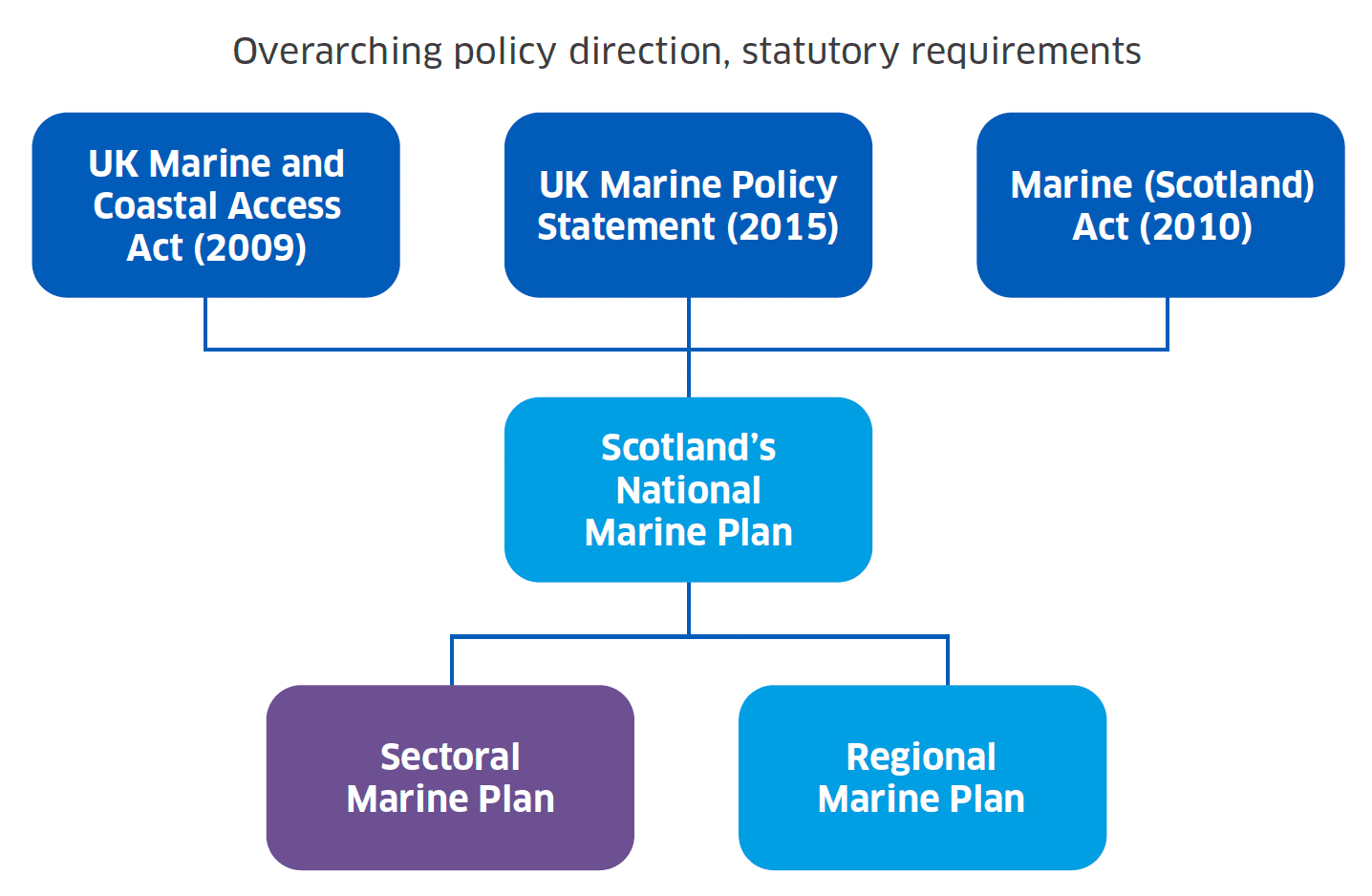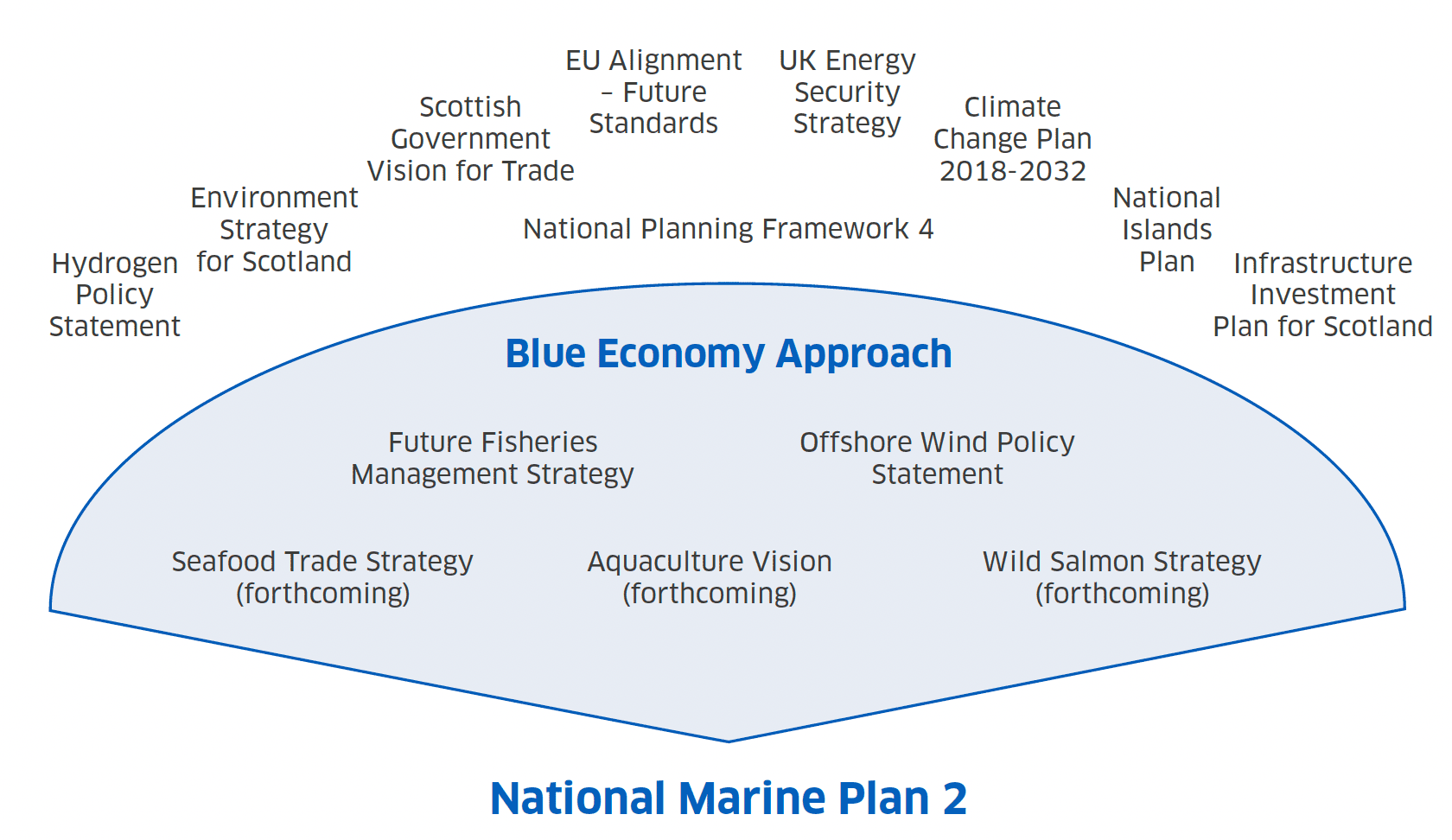National marine plan 2: engagement strategy
Stakeholder engagement strategy and statement of public participation for Scotland's national marine plan 2.
2. Introduction
2.1 What is marine planning and who does it?
Marine planning is a practice to help manage the multiple uses of our seas and oceans. Unlike other types of planning, such as land-use planning or urban planning, marine planning is a relatively new activity in Scotland – it was introduced as a statutory duty for Scottish Ministers under the "Marine Acts" in 2009-10[1]. Marine planning activities often result in the creation of a plan, strategy or framework, that is then used to guide decisions on how, when and by whom, certain activities can be undertaken in the marine environment.
In Scotland, marine planning activities are undertaken nationally, regionally and for specific sectors (Figure 1). To date, marine planning activities in Scotland have resulted in a statutory National Marine Plan, several draft Regional Marine Plans and a Sectoral Marine Plan for Offshore Wind, described below.
The Scottish Government's Marine Scotland Directorate undertakes national marine planning activities in accordance with the requirements and conditions set out in the Marine Acts. For example, under section 5 the Marine Scotland Act (2010) ("the 2010 Act"), National Marine Plans must include policies for the sustainable development of Scotland's seas and set objectives for economic, social and marine ecosystems and mitigation of and adaptation to climate change. The Scottish Ministers must also state their policies on the contribution of designated conservation sites for the protection and enhancement of the sea and these will help to ensure that our international commitments on conservation are met. The current National Marine Plan (2015) also sets the wider context for marine planning within Scotland, including what should be considered when creating regional marine plans and sectoral marine plans.
Marine Scotland Directorate undertakes spatially explicit planning for specific marine sectors, including offshore wind and marine conservation practices, such as marine protected areas. The sectoral marine plan for offshore wind energy, published in 2020, identifies sustainable plan options for the development of commercial-scale offshore wind energy in Scotland.
Finally, Marine Scotland Directorate supports Regional Marine Planning Partnerships, made up of local stakeholders who reflect marine interests in their region, to undertake regional marine planning activities, encouraging more local ownership and decision-making about specific issues within their respective areas. Marine Planning Partnerships are currently developing regional marine plans in three out of eleven marine regions[2] set out in the Scottish Marine Regions Order 2015 – Orkney, Clyde and Shetland. A map showing the eleven marine regions is provided in the Statement of Public Participation (Annex A).

Graphic text below:
Overarching policy direction, statutory requirements
- UK Marine and Coastal Access Act (2009)
- UK Marine Policy Statement (2015)
- Marine (Scotland) Act (2010)
- Scotland's National Marine Plan
- Sectoral Marine Plan
- Regional Marine Plan
2.2 Why are we updating the National Marine Plan?
Scottish Ministers are required under the Marine (Scotland) Act 2010 (MSA) to prepare and adopt a national marine plan for the Scottish marine area, as well as keep the plan under review. The first National Marine Plan, adopted in 2015, sets out strategic policies to guide the sustainable development of Scotland's marine resources from Mean High Water Springs[3] out to 200nm. The 2015 plan contains general policies for the sustainable development and use of Scotland's marine area, as well as sector-specific policies for sectors such as sea fisheries, aquaculture, defence, aggregates, offshore wind and other marine renewables.
Since its adoption, the National Marine Plan (2015) has been reviewed twice, in line with statutory requirements to monitor and report on: the effects of the plan's policies, the effectiveness of those policies in securing the plan's objectives, its progress in securing its objectives, and other relevant matters.
- The first review, published in 2018, found the plan to be effective but pointed to EU Exit as one reason that might justify future revisions.
- The second review, published in 2021, suggested that the urgent need to tackle the twin crises of climate change and biodiversity loss, amongst other factors, had become core drivers for a new plan.
The 2021 review found that there was a clear need to update NMP1 to reflect the significant changes in the wider policy and legislative landscape, rapid developments in technology, the need to deliver a green recovery from COVID-19, as well as to reflect our improved understanding of the marine environment, including the socio-economic benefits of marine development. The review highlighted that the Scottish Government's commitment to delivery of a Blue Economy Approach, to establish and grow "blue" as a natural capital asset in Scotland, would be an important policy development and that the policies in the National Marine Plan would need to reflect and be aligned with the ambitions within the Blue Economy Vision.

Graphic text below:
- Hydrogen Policy Statement
- Environment Strategy for Scotland
- Scottish Government Vision for Trade
- EU Alignment – Future Standards
- UK Energy Security Strategy
- Climate Change Plan 2018-2032
- National Islands Plan
- Infrastructure Investment Plan for Scotland
- National Planning Framework 4
Blue Economy Approach
- Future Fisheries Management Strategy
- Offshore Wind Policy Statement
- Seafood Trade Strategy (forthcoming)
- Aquaculture Vision (forthcoming)
- Wild Salmon Strategy (forthcoming)
National Marine Plan 2
In March 2022, we published the Blue Economy Vision for Scotland, outlining its long-term ambition for shared stewardship of our marine environment by 2045[4].
The vision sets out a new approach that puts environmental and societal issues on a more equal footing with economic interests. As identified by the 2021 review of NMP1, the updated National Marine Plan will act as a key delivery mechanism for the outcomes in the Blue Economy Vision.
The Blue Economy Vision makes clear that there are difficult choices ahead to deliver the aspirations for the sustainable management of Scotland's seas and coasts by 2045, which will require consideration of co-dependencies, synergies or trade-offs between different interests and any cumulative impacts. Applying a 'blue economy' approach to the national marine planning process will help us to reconcile these difficulties and differences in a manner which is right for Scotland's people and seas.
In September 2022, Scottish Ministers announced their intention to update the National Marine Plan (2015), in line with these findings and feedback from stakeholders.
2.3 Why is Marine Scotland Directorate engaging stakeholders on the development of NMP2?
Securing the involvement of our stakeholders from the beginning of the planning process is essential to the creation of a national marine plan that will benefit not only individual sectors, but also people living and relying on, as well as visiting, Scotland's marine environment.
We recognise that working with stakeholders often results in better information and evidence to inform policy decisions, such as the locations of certain activities in the marine space, or insight as to how certain stakeholder groups would be affected by or perceive a given policy. Through participating in the plan development, stakeholders also come away with a better understanding of policies and how they may apply in practice.
The Scottish Ministers have a statutory obligation to prepare and publish a Statement of Public Participation, outlining when and how they will engage with stakeholders during the preparation of a national marine plan (in accordance with paragraphs 5 and 6 of schedule 6 of the Marine and Coastal access Act 2009 ("the 2009 Act", and paragraphs 4 and 5 of schedule 1 of the 2010 Act. There is also a statutory obligation under part 1 of the Environmental Assessment (Scotland) Act 2005 ("the 2005 Act") to consult relevant stakeholders on the draft plan and accompanying strategic environmental assessments. Further, the Marine Acts require that public authorities must take authorisation or enforcement decisions in accordance with the National Marine Plan, unless relevant considerations indicate otherwise.
To that end, this stakeholder engagement strategy, alongside the Statement of Public Participation provided in Annex A, will outline:
- what we want to achieve through engaging stakeholders on the development of NMP2;
- how we hope to achieve that, and;
- how stakeholders can be involved.
2.4 How does this tie in with other stakeholder engagement carried out by Marine Scotland Directorate?
We recognise that the Marine Scotland Directorate already carries out extensive engagement with stakeholders as part of its day-to-day business, for example, in relation to specific policy or regulatory changes. We also recognise that our stakeholders put considerable time and effort into working with us on these issues.
Prior to developing this strategy, the Marine Scotland Directorate undertook an informal review of its own previous stakeholder engagement activities, as well as engagement activities run by other Scottish Government directorates, in order to identify best practices and lessons learnt. Relevant Scottish Government officials were asked a series of open-ended questions relating to their experience of stakeholder engagement, any challenges, risks and opportunities associated with working with stakeholders, and their expectations and objectives for engaging stakeholders through the national marine planning process. More than 30 officials from policy, delivery, communications and analytical teams participated in a series of sessions from November to December 2021, providing over 100 responses to each of the questions.
We have incorporated the findings of this internal review into the vision, outcomes and principles that shape this strategy. In particular, in order to avoid the risk of stakeholder fatigue and disinterest in the marine planning process, we will identify opportunities to use existing engagement mechanisms and engage our stakeholders and the public in a manner which is proportionate and effective. Examples include:
- working with existing stakeholder working groups;
- attendance at the regular Regional Inshore Fishery Groups' Chairs meeting to provide progress updates and collect feedback;
- attendance at the meetings of Regional Marine Planning Partnerships;
- sharing of evidence and views gathered through other consultation processes more broadly, where the necessary consent has been sought and granted, to inform policy development.
2.5 How to read this strategy
The main text of the strategy provides an overview of what we want to achieve through engaging stakeholders on the development of NMP2. We suggest reviewing the vision, outcomes, actions and principles – these will shape our stakeholder engagement during the development of NMP2. We will monitor progress against these outcomes and principles and adjust our engagement actions as required.
The statutory Statement of Public Participation (SPP) (Annex A), provides a chronological timetable of proposed stakeholder engagement activities, including target stakeholders and methods for engagement. The SPP should be read in conjunction with the main text of this strategy.
Contact
There is a problem
Thanks for your feedback